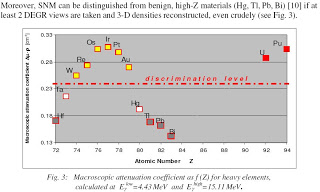The combined cargo inspection system envisaged will automatically and reliably detect small, operationally-relevant amounts of concealed explosives and SNM. It will be cost-effective, employing largely-common hardware, but different reactions and data acquisition modes. The system is also inherently multi-level in the sense that, if an alarm is raised, the cargo item in question is subjected to further screening within the system itself, until it can be definitely cleared or declared suspect. Throughput is projected to be 10-20 aviation containers/hr.
At the heart of the concept is a dual-purpose accelerator for mass-2 ions, alternately delivering several mA (cw) of H2+ and sub-mA (pulsed) deuterons. As shown by the 9.172 MeV emission line data of the present work, beam quality requirements are only moderately stringent, which opens up the field to accelerator technologies that are compact and robust.
Note – Nextbigfuture observation is that this proposed security system could be made a lot smaller and cheaper if handheld proton beam accelerators could be built (DARPA proposed them and we covered them).
Berkeley labs is targeting 10 GeV for every one meter of laser-plasma accelerator.
To construct a practicable system with good performance characteristics, judicious choices of gamma-ray energies and populating reactions employing low-energy beams at sub-mA intensities are essential. To this end, a comprehensive literature study of reaction-induced, thick-target gamma
yields has been performed
The U.S. Government passed a Bill in 2007, which mandates that, within five years, 100% of all U.S.-bound maritime cargo, as well as all aviation cargo loaded onto passenger aircraft, be scanned for the above threat materials in foreign ports prior to shipment. Indeed, this implies that a very large number of inspection systems with capabilities beyond the present state-of-the-art will be needed, at a global hardware outlay estimated to exceed 5000M$ (more than 1000 systems, at ~5M$ each).
A concept is presented for a dual-purpose ion-accelerator, capable of serving as radiation source in a versatile, nuclear-reaction-based inspection system for massive-cargo. The system will automatically and reliably detect small, operationally-relevant quantities of concealed explosives and Special Nuclear Materials (SNM). It will be cost-effective, employing largely common hardware, but different reactions and data acquisition modes. Typical throughput is expected to be 10-20 aviation containers/hr, at the beam intensities specified below.
With such an inspection system, explosives are detected via g-Resonance Absorption (GRA) in 14N using 9.17 MeV g-rays produced in 13C(p,g), and SNM via Dual-Discrete-Energy g-Radiography (DEGR) with 15.11 & 4.43 MeV 12C g-rays from 11B(d,n). Simultaneously with the scan, 1-17 MeV neutrons from the latter reaction will yield complementary information, both on explosives and on SNM, via Fast-Neutron Resonance Radiography (FNRR). Few-view radiography will be implemented throughout, since spatial reconstruction of threat-object densities reduces false-alarm rates drastically.
Nevertheless, if a cargo item does alarm the system on SNM, confirmation of its presence and composition will be effected via a secondary-screening technique, namely, induced-fission decay-signatures, employing the 11B(d,n) neutrons. This should only be required in solitary cases and will thus not impede cargo flow to any appreciable extent. For explosives, the GRA/FNRR combination comprehensively covers the entire spectrum of substances in the arena and no secondary-screening technique should be required.
The essence of the accelerator concept is a fixed-energy machine, alternately delivering mass-2 beams of H2+ (3 mA, cw) and deuterons (0.2 mA, pulsed) for GRA and DEGR/FNRR, respectively. It will operate at precisely double the GRA resonance energy of Ep=1.746 MeV (namely, 3.492 MeV) and require beam-energy resolution no better than ~15 keV (FWTM).
This specification was confirmed in a recent measurement, first reported here, of the GRA emission-linewidth obtained with H2+ ions, when driving the resonance into the depth of a moderately-thick 13C target. For most acceleration techniques, such beam-energy resolution requirements are not unduly stringent, which works in favour of the high-current requirement. On deuteron beams there are no energy resolution constraints, as the 11B(d,n) reaction is nonresonant.

Brian Wang is a Futurist Thought Leader and a popular Science blogger with 1 million readers per month. His blog Nextbigfuture.com is ranked #1 Science News Blog. It covers many disruptive technology and trends including Space, Robotics, Artificial Intelligence, Medicine, Anti-aging Biotechnology, and Nanotechnology.
Known for identifying cutting edge technologies, he is currently a Co-Founder of a startup and fundraiser for high potential early-stage companies. He is the Head of Research for Allocations for deep technology investments and an Angel Investor at Space Angels.
A frequent speaker at corporations, he has been a TEDx speaker, a Singularity University speaker and guest at numerous interviews for radio and podcasts. He is open to public speaking and advising engagements.






